BitFenix Ronin Case Review
by Dustin Sklavos on July 22, 2013 12:00 PM EST- Posted in
- Cases/Cooling/PSUs
- bitfenix
- ATX
Noise and Thermal Testing
The BitFenix Ronin unfortunately enters noise and thermal testing a bit hobbled. While I would've appreciated a fan controller, it's not strictly necessary. BitFenix is using two of their Spectre fans in the Ronin, and these fans are incredibly quiet. That's the upshot.
The downside is that there are only two quiet 120mm fans tasked with keeping the Ronin cool, and that plays hell on performance. You'll see Ronin fall into the same trap that a lot of silent cases do: without adequate airflow, internal cooling has to pick up the slack and runs louder as a result. Silent computing is a difficult balancing act and one that the Ronin is unable to get a good handle on.
Ambient temperatures were between 23C and 24C for testing.

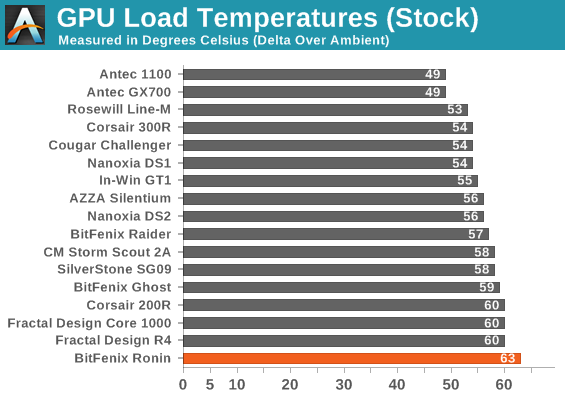
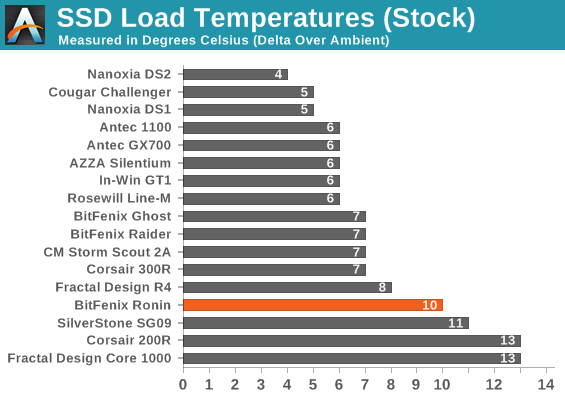
You can see stock cooling performance is pretty poor and easily bested by other, less expensive cases.
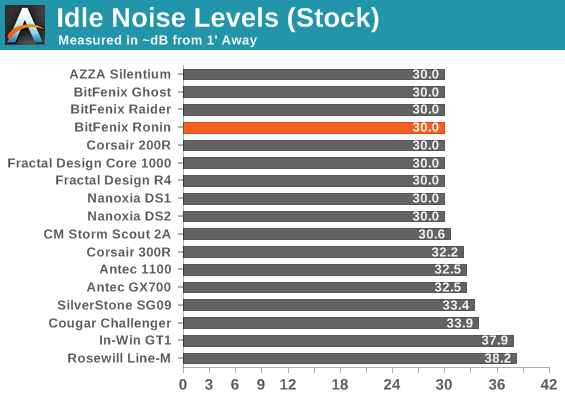

The poor thermal performance could at least be justified if the Ronin did a better job with noise, but it's just not there in any capacity and it only gets worse when you overclock the testbed.
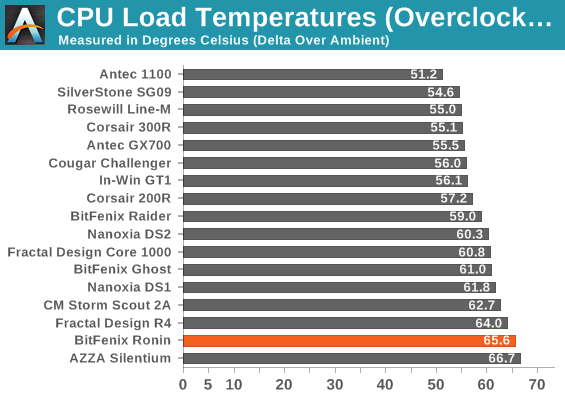
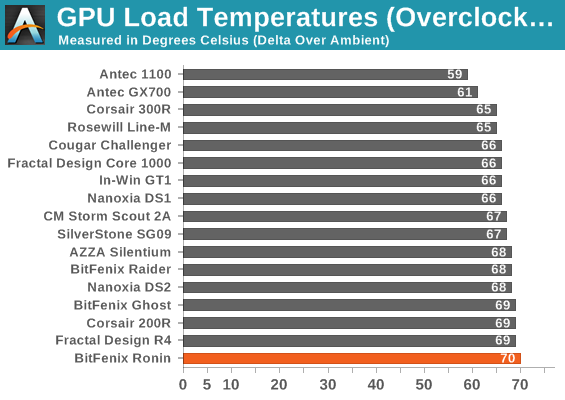

Overclock the testbed and suddenly the Ronin is finishing dead last. The two Spectre fans just aren't up to the task of keeping the system cool. Low case volume and low airflow are a deadly combination.
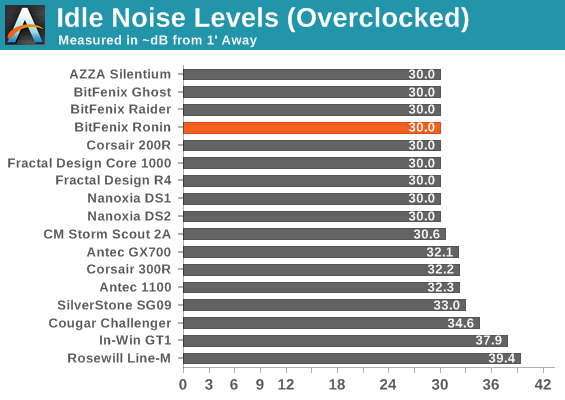
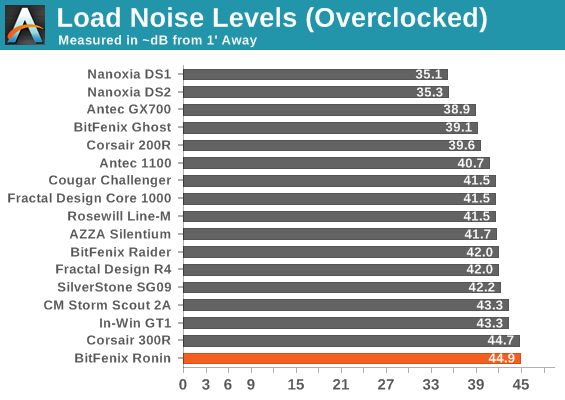
Noise levels are unfortunately unsurprising. The Ronin just runs hot and loud under load.
It's hard not to feel at least a little disheartened by these results, and I went into full fat testing with some trepidation.
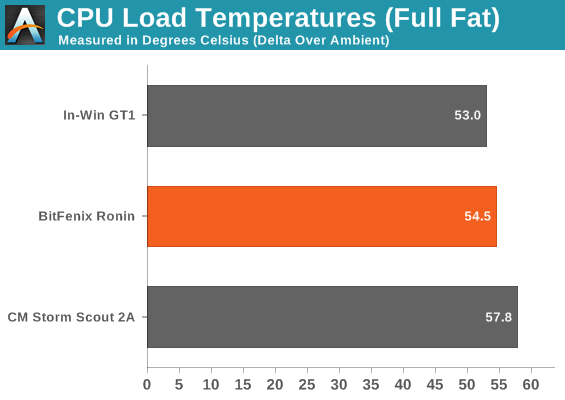
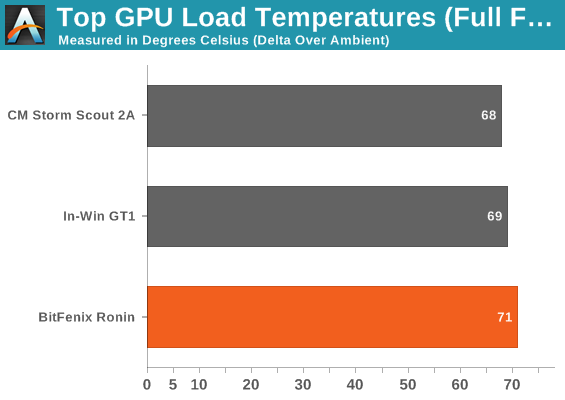
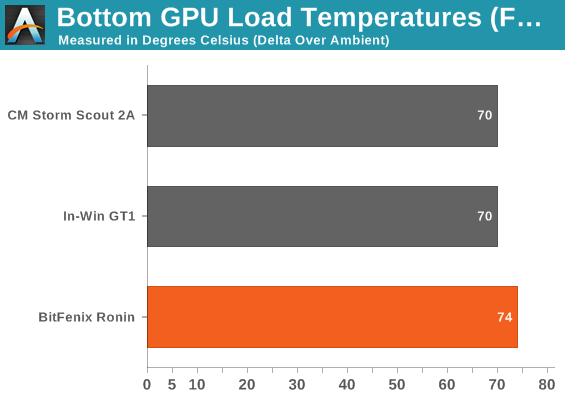

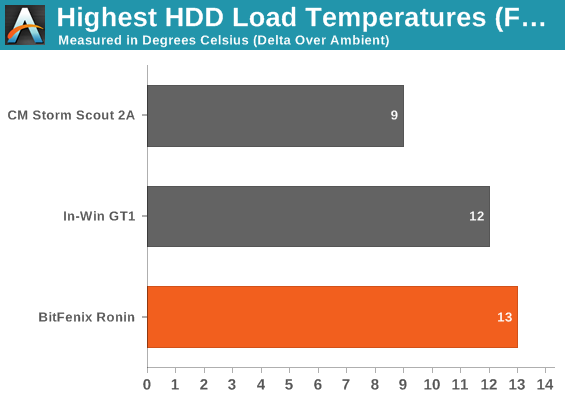
Note that the CPU runs hotter under load in our basic overclocked testbed than in our full fat despite the fact that it's running at the same voltage and speed in both. The GTX 580 blower-style coolers are able to pull much more weight than the GTX 560 Ti's open air cooler, keeping the Ronin from cooking the CPU. Unfortunately, the GPUs are running toasty in the process, hitting the 90s under load and actually maxing out their fan speeds.
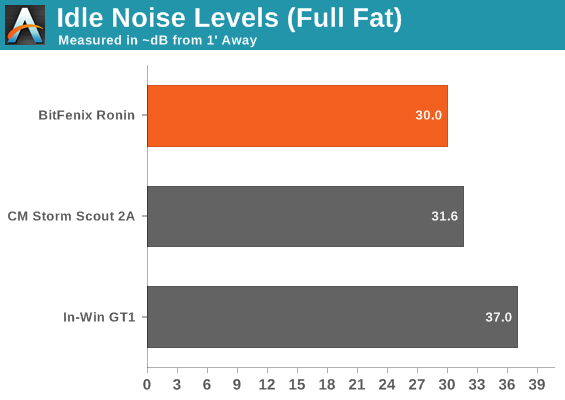
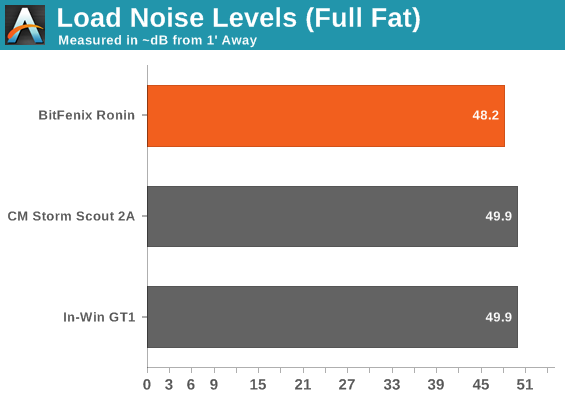
It's "quieter" than the other cases in its class, but that's not saying much. The fact remains that airflow is a serious issue in the Ronin.










30 Comments
View All Comments
1Angelreloaded - Tuesday, July 23, 2013 - link
Innovation, is a relative term to the user, some feature some users find attractive are to some a nightmare or not pleasing, to me while thumb screws are nice and fast, they are unsightly on a case, and all I can say is "Since when did we become that lazy, to not use a screwdriver?". Moot point but I'm waiting for a Case manufacturer to have a prefabricated modular case that doesn't have industrial designed segments, and doesn't cost an arm or a leg like MM or Caselabs. there is a distinction to what can be considered "Premium" or "Ingenuity" and in the PC world I have to say form and function is a must otherwise companies like LaCie would have went the way of the dodo. We need a new version of mainstream and Enthusiast parts, and a definitive separation of the two. TBH the whole x79 sandy-e is way behind on features of the native chipset and even with Ivy-e being released for the socket its simply not practical for the pricepoint while on the mainstream z77 and z87 you are stuck with onboard graphics that you pay for but can't use without taking a hit on your fps. I diverge from the point sorry, Cases are very very similar in that respect the only definition between the 2 different market segments is price and features we should have, that should be a no brainer simply are not there yet, or are in overpriced cases in which your better putting your money elsewhere, like people have done before no ssd drive cage, no problem that's what Velcro is for.techxx - Monday, July 22, 2013 - link
That is a shame. IIRC though, there are supposed to be some new Mini-ITX cases from them on the horizon. Full ATX cases just don't make sense to me anymore anyway! Micro-ATX should be the largest form factor on the market now, with Mini-ITX being the norm.RagnarKon - Monday, July 22, 2013 - link
While I do welcome innovation in the mini-ATX and especially the micro-ATX market... ATX cases absolutely make sense to me. On my main system I have every PCIe slot filled (except the one blocked by the GPU cooler) and I'm not even running an SLI setup.Also, I am disappoint BitFenix... I had high hopes.
Grok42 - Tuesday, July 23, 2013 - link
I would agree with everything techxx said with a small exception that he probably assumed wasn't needed be explicitly said. Is there a place for ATX cases? Sure, I plan on using ATX for my home servers for the foreseeable future. However, the world doesn't need another ATX case. What we need are many more mITX and mATX designs.techxx - Tuesday, July 23, 2013 - link
There will always be that 0.01% of users who require a full-ATX case while the remaining 99.99% would be more than adequately covered with a mini-ITX or micro-ATX case. Unless you have 3-way SLI or a ton of PCI devices (which makes you even rarer), m-ITX and micro-ATX pack one hell of a punch nowadays.Aeolus98 - Monday, July 22, 2013 - link
It seems like what they're trying to do is to keep the case looking streamlined, with no unevenness on the sides, so that dictates a (fairly) standard in through the front, out through the back and top. It's a great design when executed properly, even with no gpu fan vent, like the HAF or the antec 1200. They should have put more fan space on the front and bumped it up from 2x120mm to 2x140mm to provide a bit of airflow. I don't really see your point about price, though, with the second 120mm on the front it could possibly be on par with something like the antec 900 series, while that costs a bit more OTOH.DanNeely - Monday, July 22, 2013 - link
Why do you only have 2 comparison systems for the full fat test? Looking at the NZXT 530 review from a few days ago there are several others that could've been added to help fill the table out.kelstertx - Monday, July 22, 2013 - link
Not everyone uses multiple 2-slot-wide video cards and makes monster systems with 4 drives that need 3+ fans to cool. This case would be perfectly fine for 90% of the systems I end up making for friends and family -- those only get a single 120mm fan, and it's rare that they even have standalone video cards. Yes, the price does need to come down a bit, and someone looking to load this thing to the hilt might do better to look elsewhere, but keep in mind that the gamer market is a small percentage of the market, compared to all the people who just do email, web browsing, and facebook stuff. So I'd say a "miss" for high power gamers with unlimited budgets... but a nice looking and totally usable, albeit slightly expensive case that would be more than fine for everyone I know personally.JDG1980 - Monday, July 22, 2013 - link
Any modern ATX case of reasonable quality will cool a single-GPU system. The question is why you should buy the Ronin instead of, say, the Fractal Design Define R4 (which is about the same price and much quieter, with better thermals) or the Antec GX700 (which costs only $59 and bests the Ronin in everything but idle noise levels). I'm just not seeing the value proposition here.Grok42 - Tuesday, July 23, 2013 - link
I'm with you on your build style. Keep it simple and inexpensive. What doesn't follow is why you would use this case. For something without a GPU it seems like an small mATX and mITX would be perfect.